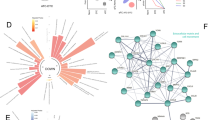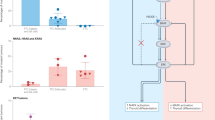Abstract
Molecular eventsthat lead to the development of autonomously functioning thyroid nodules (AFTNs) are somatic mutations of the thyrotropin receptor (TSHR) in approximately 60% of the nodules and less frequently, somatic mutations in the Gsα protein. However, AFTNs without known mutations indicate that other causes remain to be identified. Moreover, the impact of constitutively activating TSHR mutations on the signal transduction network of the thyroid epithelial cell is unknown. We therefore investigated gene expression in 15 AFTNs and their surrounding tissue using Affymetrix GeneChips. Most prominently, data analysis revealed a changed pattern of gene expression in the TGF-β signaling cascade and 25 differentially regulated genes in AFTNs, including thyroid peroxidase, type I iodothyronine deiodinase and sialyltransferase (SIAT) 1. Strikingly coexpression of SIAT 1 and TSHR in COS-7 cells increased TSH binding and cell surface expression of the TSHR. Moreover, differences in gene expression patterns for AFTNs with and without TSHR mutations indicate specific alterations of signal transduction in AFTNs without TSHR mutations. These results suggest that AFTNs with TSHR mutations harbor further mechanisms of forward stimulation. Furthermore, they give important leads to elucidate the molecular etiology of AFTNs without TSHR mutations.
This is a preview of subscription content, access via your institution
Access options
Subscribe to this journal
Receive 50 print issues and online access
$259.00 per year
only $5.18 per issue
Buy this article
- Purchase on Springer Link
- Instant access to full article PDF
Prices may be subject to local taxes which are calculated during checkout





Similar content being viewed by others
References
Arturi F, Capula C, Chiefari E, Filetti S and Russo D . (1998). Exp. Clin. Endocrinol. Diabetes, 106, 234–236.
Biebermann H, Schoneberg T, Schulz A, Krause G, Gruters A, Schultz G and Gudermann T . (1998). FASEB J., 12, 1461–1471.
Colletta G, Cirafici AM and Di Carlo A . (1989). Cancer Res., 49, 3457–3462.
Coyle P, Philcox JC, Carey LC and Rofe AM . (2002). Cell Mol. Life Sci., 59, 627–647.
Dahlquist KD, Salomonis N, Vranizan K, Lawlor SC and Conklin BR . (2002). Nat. Genet., 31, 19–20.
Depoortere F, Pirson I, Bartek J, Dumont JE and Roger PP . (2000). Mol. Biol. Cell, 11, 1061–1076.
Eisen MB, Spellman PT, Brown PO and Botstein D . (1998). Proc. Natl. Acad. Sci. USA, 95, 14863–14868.
Eszlinger M, Krohn K, Kratzsch J, Voigt C and Paschke R . (2001a). Thyroid, 11, 125–135.
Eszlinger M, Krohn K and Paschke R . (2001b). J. Clin. Endocrinol. Metab., 86, 4834–4842.
Fuhrer D, Mix M, Wonerow P, Richter I, Willgerodt H and Paschke R . (1999). Thyroid, 9, 757–761.
Gärtner R, Schopohl D, Schaefer S, Dugrillon A, Erdmann A, Toda S and Bechtner G . (1997). Thyroid, 7, 633–640.
Grande M, Franzen A, Karlsson JO, Ericson LE, Heldin NE and Nilsson M . (2002). J. Cell Sci., 115, 4227–4236.
Grubeck-Loebenstein B, Buchan G, Sadeghi R, Kissonerghis M, Londei M, Turner M, Pirich K, Roka R, Niederle B and Kassal H . (1989). J. Clin. Invest., 83, 764–770.
Hedinger C . (1988). Histological Typing of Thyroid Tumors. Springer Verlag: Berlin/Heidelberg/New York.
Huang Y, Prasad M, Lemon WJ, Hampel H, Wright FA, Kornacker K, LiVolsi V, Frankel W, Kloos RT, Eng C, Pellegata NS and de la Chapelle A . (2001). Proc. Natl. Acad. Sci. USA, 98, 15044–15049.
Kretzschmar M, Doody J and Massague J . (1997). Nature, 389, 618–622.
Kretzschmar M, Doody J, Timokhina I and Massague J . (1999). Genes Dev., 13, 804–816.
Krohn K, Emmrich P, Ott N and Paschke R . (1999). Thyroid, 9, 241–246.
Libert F, Lefort A, Gerard C, Parmentier M, Perret J, Ludgate M, Dumont JE and Vassart G . (1989). Biochem. Biophys. Res. Commun., 165, 1250–1255.
Lopez-Casillas F, Wrana JL and Massague J . (1993). Cell, 73, 1435–1444.
Lutz M and Knaus P . (2002). Cell Signal., 14, 977.
Miyazono K . (1997). Int. J. Hematol., 65, 97–104.
Neumann S, Krause G, Chey S and Paschke R . (2001). Mol. Endocrinol., 15, 1294–1305.
Oda Y, Sanders J, Roberts S, Maruyama M, Kiddie A, Furmaniak J and Smith BR . (1999). J. Clin. Endocrinol. Metab., 84, 2119–2125.
Pang XP, Park M and Hershman JM . (1992). Endocrinology, 131, 45–50.
Park ES, Kim H, Suh JM, Park SJ, You SH, Chung HK, Lee KW, Kwon OY, Cho BY, Kim YK, Ro HK, Chung J and Shong M . (2000). Mol. Endocrinol., 14, 662–670.
Parma J, Duprez L, Van Sande J, Cochaux P, Gervy C, Mockel J, Dumont J and Vassart G . (1993). Nature, 365, 649–651.
Paschke R and Ludgate M . (1997). N. Engl. J. Med., 337, 1675–1681.
Ribeiro-Neto F, Urbani J, Lemee N, Lou L and Altschuler DL . (2002). Proc. Natl. Acad. Sci. USA, 99, 5418–5423.
Sandrock D, Olbricht T, Emrich D, Benker G and Reinwein D . (1993). Acta Endocrinol. (Copenh.), 128, 51–55.
Schoneberg T, Yun J, Wenkert D and Wess J . (1996). EMBO J., 15, 1283–1291.
Taton M, Lamy F, Roger PP and Dumont JE . (1993). Mol. Cell Endocrinol., 95, 13–21.
Trulzsch B, Krohn K, Wonerow P, Chey S, Holzapfel HP, Ackermann F, Fuhrer D and Paschke R . (2001). J. Mol. Med., 78, 684–691.
Trulzsch B, Krohn K, Wonerow P and Paschke R . (1999). Biotechniques, 27, 266–268.
Tsushima T, Arai M, Saji M, Ohba Y, Murakami H, Ohmura E, Sato K and Shizume K . (1988). Endocrinology, 123, 1187–1194.
Vanvooren V, Allgeier A, Nguyen M, Massart C, Parma J, Dumont JE and Van Sande J . (2001). Eur. J. Endocrinol., 144, 605–610.
Vicencio AG, Eickelberg O, Stankewich MC, Kashgarian M and Haddad GG . (2002). J. Appl. Physiol., 93, 1123–1130.
Voigt C, Holzapfel H and Paschke R . (2000). FEBS Lett., 486, 208–212.
Westfall PH and Young SS . (1993). Resampling-based Multiple Testing: Examples and Methods for Multiple P value Adjustment. John Wiley & Sons: New York.
Wonerow P, Chey S, Fuhrer D, Holzapfel HP and Paschke R . (2000). Clin. Endocrinol. (Oxf.), 53, 461–468.
Wonerow P, Schoneberg T, Schultz G, Gudermann T and Paschke R . (1998). J. Biol. Chem., 273, 7900–7905.
Zhang K, Noda M, Vass WC, Papageorge AG and Lowy DR . (1990). Science, 249, 162–165.
Acknowledgements
We are grateful to Gudrun Bethge, Eileen Bösenberg and Petra Süptitz for their excellent technical assistance. This work was supported by a grant from the Deutsche Forschungsgemeinschaft (DFG/Pa423/10-1) and the BMBF Interdisciplinary Center for Clinical Research at the University of Leipzig (01KS9504, Projects B20 and B14, Z16-CHIP2). The microarray analysis was conducted at the IZKF Leipzig core facility. KK is supported by IZKF Leipzig, BMBF Interdisciplinary Center for Clinical Research at the University of Leipzig 9504 (01KS 9504, project Z3).
Author information
Authors and Affiliations
Corresponding author
Rights and permissions
About this article
Cite this article
Eszlinger, M., Krohn, K., Frenzel, R. et al. Gene expression analysis reveals evidence for inactivation of the TGF-β signaling cascade in autonomously functioning thyroid nodules. Oncogene 23, 795–804 (2004). https://doi.org/10.1038/sj.onc.1207186
Received:
Revised:
Accepted:
Published:
Issue Date:
DOI: https://doi.org/10.1038/sj.onc.1207186
Keywords
This article is cited by
-
Molecular pathogenesis of nodular goiter
Langenbeck's Archives of Surgery (2011)
-
Absence of a specific radiation signature in post-Chernobyl thyroid cancers
British Journal of Cancer (2005)
-
Gene expression in thyroid autonomous adenomas provides insight into their physiopathology
Oncogene (2005)



